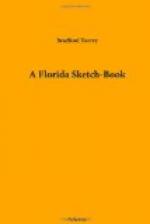As for the wood, the edge of the hammock, through which the road passes, there were no birds in it. It was one of those places (I fancy every bird-gazer must have had experience of such) where it is a waste of time to seek them. I could walk down the road for two miles and back again, and then sit in my room at the hotel for fifteen minutes, and see more wood birds, and more kinds of them, in one small live-oak before the window than I had seen in the whole four miles; and that not once and by accident, but again and again. In affairs of this kind it is useless to contend. The spot looks favorable, you say, and nobody can deny it; there must be birds there, plenty of them; your missing them to-day was a matter of chance; you will try again. And you try again—and again—and yet again. But in the end you have to acknowledge that, for some reason unknown to you, the birds have agreed to give that place the go-by.
One bird, it is true, I found in this hammock, and not elsewhere: a single oven-bird, which, with one Northern water thrush and one Louisiana water thrush, completed my set of Florida Seiuri. Besides him I recall one hermit thrush, a few cedar-birds, a house wren, chattering at a great rate among the “bootjacks” (leaf-stalks) of an overturned palmetto-tree, with an occasional mocking-bird, cardinal grosbeak, prairie warbler, yellow redpoll, myrtle bird, ruby-crowned kinglet, phoebe, and flicker. In short, there were no birds at all, except now and then an accidental straggler of a kind that could be found almost anywhere else in indefinite numbers.
And as it was not the presence of birds that made the river road attractive, so neither was it any unwonted display of blossoms. Beside a similar road along the bank of the Halifax, in Daytona, grew multitudes of violets, and goodly patches of purple verbena (garden plants gone wild, perhaps), and a fine profusion of spiderwort,—a pretty flower, the bluest of the blue, thrice welcome to me as having been one of the treasures of the very first garden of which I have any remembrance. “Indigo plant,” we called it then. Here, however, on the way from New Smyrna to Hawks Park, I recall no violets, nor any verbena or spiderwort. Yellow wood-sorrel (oxalis) was here, of course, as it was everywhere. It dotted the grass in Florida very much as five-fingers do in Massachusetts, I sometimes thought. And the creeping, round-leaved houstonia was here, with a superfluity of a weedy blue sage (Salvia lyrata). Here, also, as in Daytona, I found a strikingly handsome tufted plant, a highly varnished evergreen, which I persisted in taking for a fern—the sterile fronds—in spite of repeated failures to find it described by Dr. Chapman under that head, until at last an excellent woman came to my help with the information that it was “coontie” (Zamia integrifolia), famous as a plant out of which the Southern people made bread in war time. This confession of botanical amateurishness and incompetency




